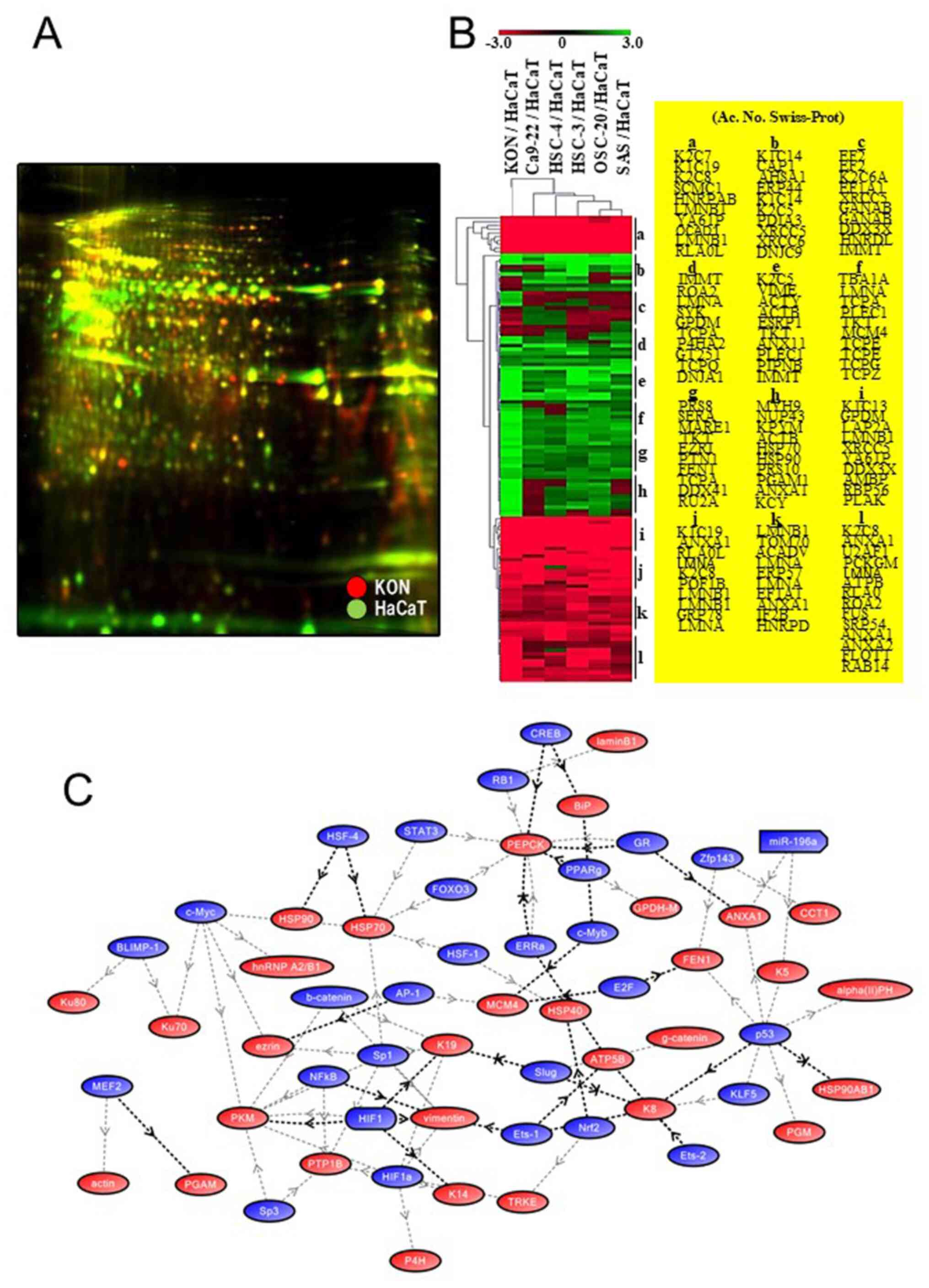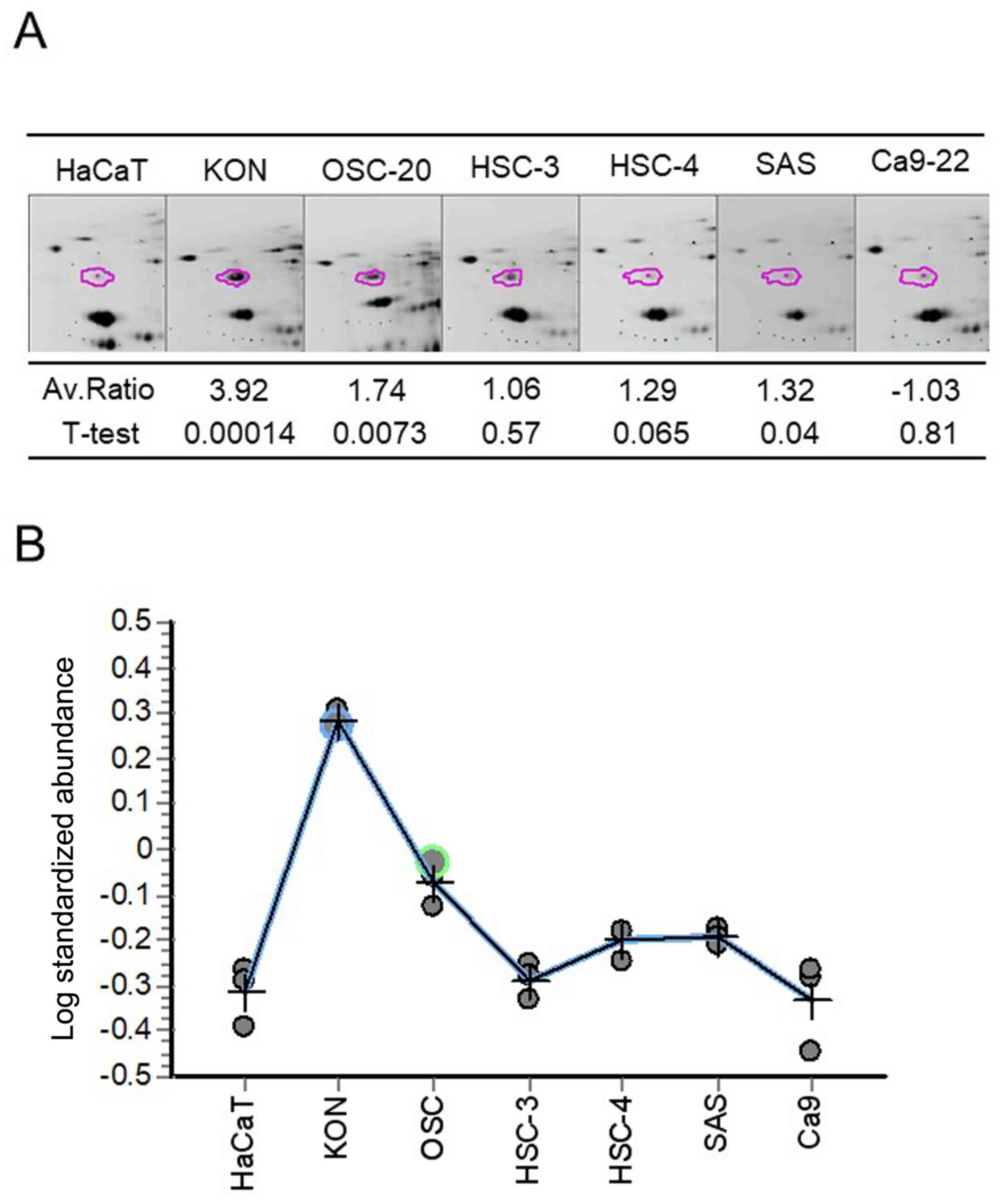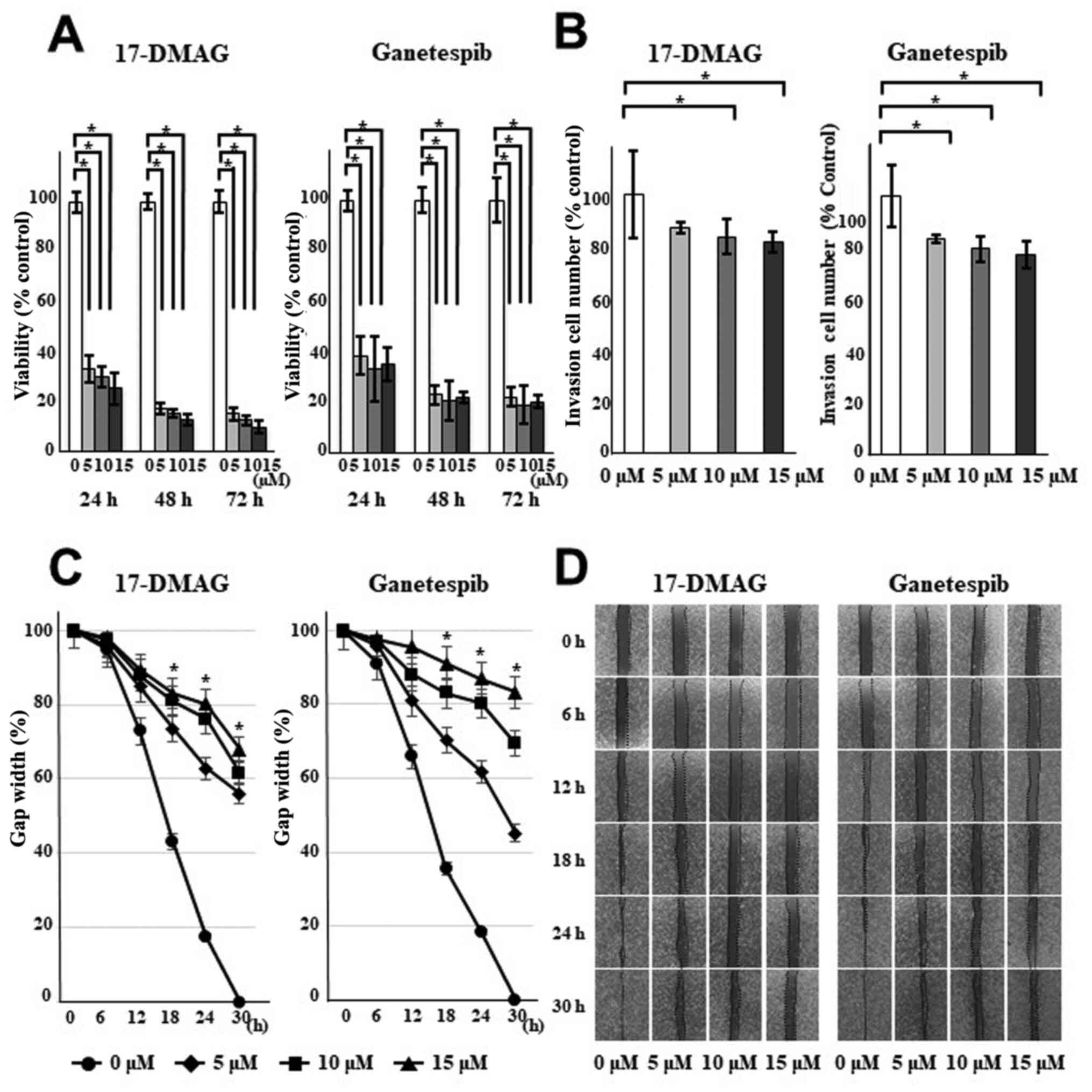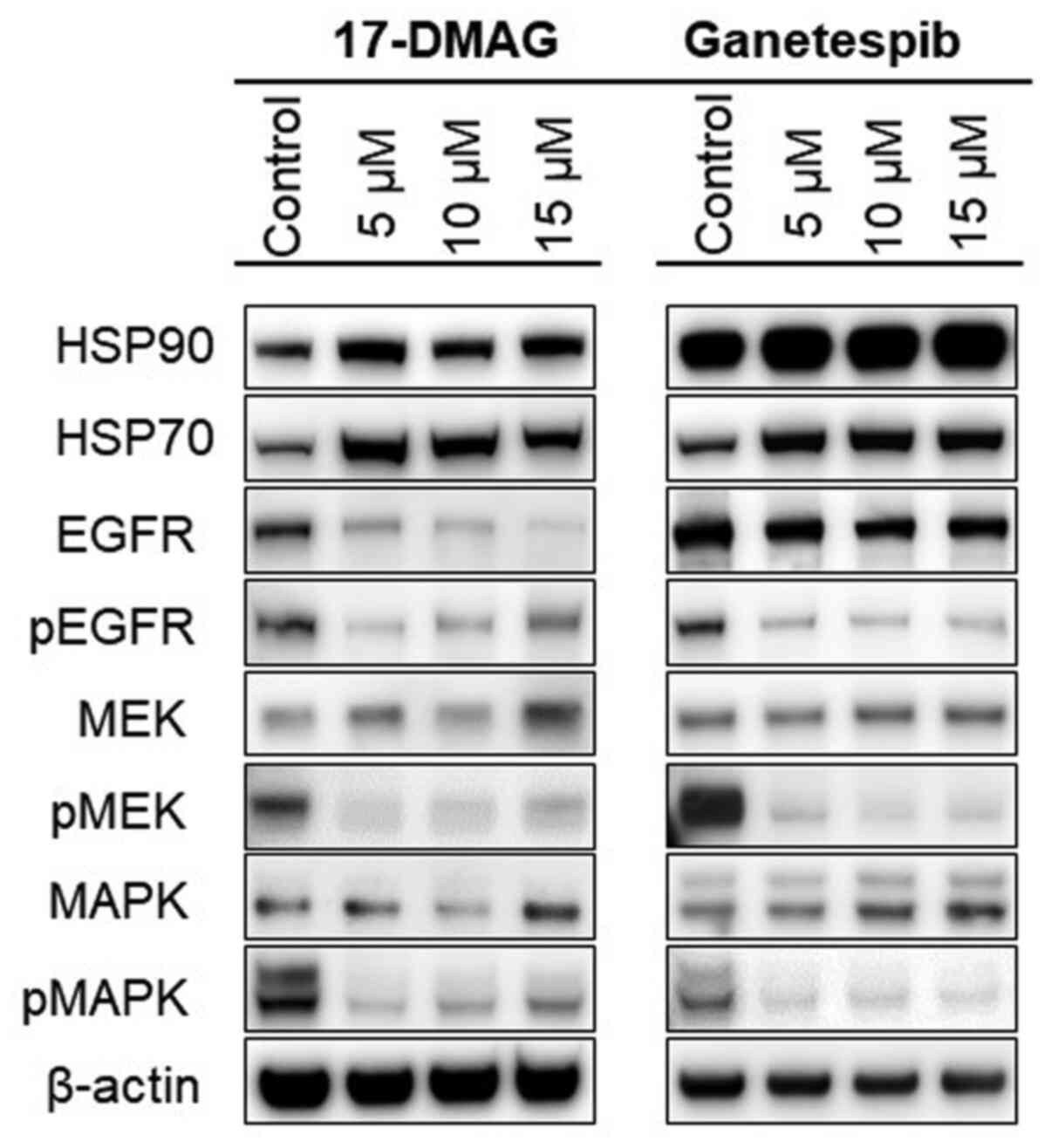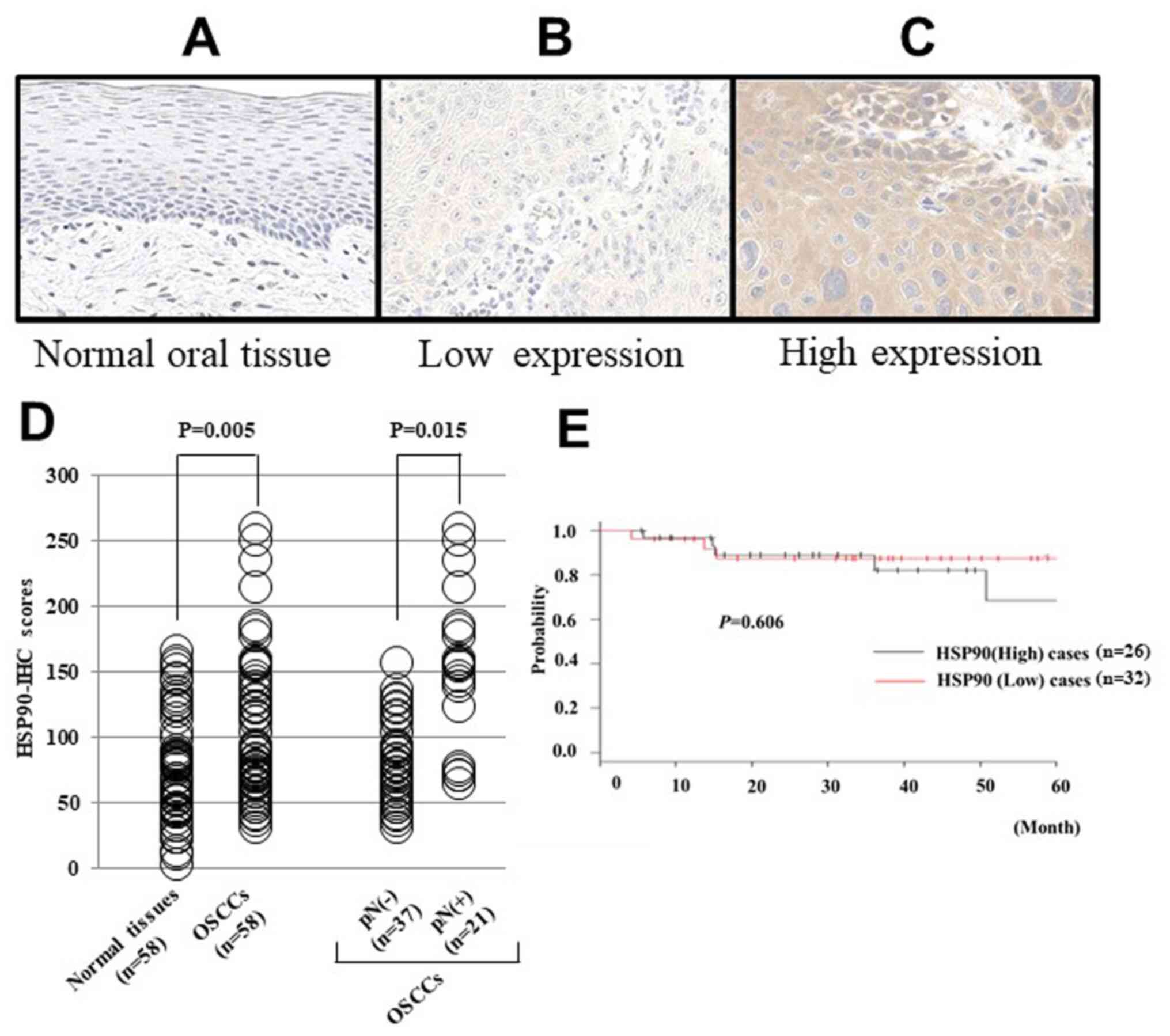|
1
|
Siegel R, Ma J, Zou Z and Jemal A: Cancer
statistics, 2014. CA Cancer J Clin. 64:9–29. 2014. View Article : Google Scholar : PubMed/NCBI
|
|
2
|
Prestwich R, Dyker K and Sen M: Improving
the therapeutic ratio in head and neck cancer. Lancet Oncol.
11:512–513. 2010. View Article : Google Scholar : PubMed/NCBI
|
|
3
|
Stransky N, Egloff AM, Tward AD, Kostic
AD, Cibulskis K, Sivachenko A, Kryukov GV, Lawrence MS, Sougnez C,
McKenna A, et al: The mutational landscape of head and neck
squamous cell carcinoma. Science. 333:1157–1160. 2011. View Article : Google Scholar : PubMed/NCBI
|
|
4
|
Srinivas PR, Verma M, Zhao Y and
Srivastava S: Proteomics for cancer biomarker discovery. Clin Chem.
48:1160–1169. 2002.PubMed/NCBI
|
|
5
|
Dabbous MK, Jefferson MM, Haney L and
Thomas EL: Biomarkers of metastatic potential in cultured
adenocarcinoma clones. Clin Exp Metastasis. 28:101–111. 2011.
View Article : Google Scholar : PubMed/NCBI
|
|
6
|
Poli G, Ceni E, Armignacco R, Ercolino T,
Canu L, Baroni G, Nesi G, Galli A, Mannelli M and Luconi M: 2D-DIGE
proteomic analysis identifies new potential therapeutic targets for
adrenocortical carcinoma. Oncotarget. 6:5695–5706. 2015. View Article : Google Scholar : PubMed/NCBI
|
|
7
|
Merkley MA, Weinberger PM, Jackson LL,
Podolsky RH, Lee JR and Dynan WS: 2D-DIGE proteomic
characterization of head and neck squamous cell carcinoma.
Otolaryngol Head Neck Surg. 141:626–632. 2009. View Article : Google Scholar : PubMed/NCBI
|
|
8
|
Bijian K, Mlynarek AM, Balys RL, Jie S, Xu
Y, Hier MP, Black MJ, Di Falco MR, LaBoissiere S and Alaoui-Jamali
MA: Serum proteomic approach for the identification of serum
biomarkers contributed by oral squamous cell carcinoma and host
tissue microenvironment. J Proteome Res. 8:2173–2185. 2009.
View Article : Google Scholar : PubMed/NCBI
|
|
9
|
Whitesell L and Lindquist SL: HSP90 and
the chaperoning of cancer. Nat Rev Cancer. 5:761–772. 2005.
View Article : Google Scholar : PubMed/NCBI
|
|
10
|
Solit DB and Rosen N: Hsp90: A novel
target for cancer therapy. Curr Top Med Chem. 6:1205–1214. 2006.
View Article : Google Scholar : PubMed/NCBI
|
|
11
|
Trepel J, Mollapour M, Giaccone G and
Neckers L: Targeting the dynamic HSP90 complex in cancer. Nat Rev
Cancer. 10:537–549. 2010. View
Article : Google Scholar : PubMed/NCBI
|
|
12
|
Taldone T, Gozman A, Maharaj R and Chiosis
G: Targeting Hsp90: Small-molecule inhibitors and their clinical
development. Curr Opin Pharmacol. 8:370–374. 2008. View Article : Google Scholar : PubMed/NCBI
|
|
13
|
Neckers L and Workman P: Hsp90 molecular
chaperone inhibitors: Are we there yet? Clin Cancer Res. 18:64–76.
2012. View Article : Google Scholar : PubMed/NCBI
|
|
14
|
Zhao M, Sano D, Pickering CR, Jasser SA,
Henderson YC, Clayman GL, Sturgis EM, Ow TJ, Lotan R, Carey TE, et
al: Assembly and initial characterization of a panel of 85
genomically validated cell lines from diverse head and neck tumor
sites. Clin Cancer Res. 17:7248–7264. 2011. View Article : Google Scholar : PubMed/NCBI
|
|
15
|
Yu M, Selvaraj SK, Liang-Chu MM, Aghajani
S, Busse M, Yuan J, Lee G, Peale F, Klijn C, Bourgon R, et al: A
resource for cell line authentication, annotation and quality
control. Nature. 520:307–311. 2015. View Article : Google Scholar : PubMed/NCBI
|
|
16
|
Koike H, Uzawa K, Nakashima D, Shimada K,
Kato Y, Higo M, Kouzu Y, Endo Y, Kasamatsu A and Tanzawa H:
Identification of differentially expressed proteins in oral
squamous cell carcinoma using a global proteomic approach. Int J
Oncol. 27:59–67. 2005.PubMed/NCBI
|
|
17
|
Onda T, Uzawa K, Nakashima D, Saito K,
Iwadate Y, Seki N, Shibahara T and Tanzawa H: Lin-7C/VELI3/MALS-3:
An essential component in metastasis of human squamous cell
carcinoma. Cancer Res. 67:9643–9648. 2007. View Article : Google Scholar : PubMed/NCBI
|
|
18
|
Nishikawa H, Ooka S, Sato K, Arima K,
Okamoto J, Klevit RE, Fukuda M and Ohta T: Mass spectrometric and
mutational analyses reveal Lys-6-linked polyubiquitin chains
catalyzed by BRCA1-BARD1 ubiquitin ligase. J Biol Chem.
279:3916–3924. 2004. View Article : Google Scholar : PubMed/NCBI
|
|
19
|
Dyrlund TF, Poulsen ET, Scavenius C,
Sanggaard KW and Enghild JJ: MS Data Miner: A web-based software
tool to analyze, compare, and share mass spectrometry protein
identifications. Proteomics. 12:2792–2796. 2012. View Article : Google Scholar : PubMed/NCBI
|
|
20
|
Hao P, Ren Y, Tam JP and Sze SK:
Correction of errors in tandem mass spectrum extraction enhances
phosphopeptide identification. J Proteome Res. 12:5548–5557. 2013.
View Article : Google Scholar : PubMed/NCBI
|
|
21
|
Yadav R and Srivastava P: Clustering,
Pathway Enrichment, and Protein-Protein Interaction Analysis of
Gene Expression in Neurodevelopmental Disorders. Adv Pharmacol Sci.
2018:36321592018.PubMed/NCBI
|
|
22
|
Lu J, Tao YF, Li ZH, Cao L, Hu SY, Wang
NN, Du XJ, Sun LC, Zhao WL, Xiao PF, et al: Analyzing the gene
expression profile of anaplastic histology Wilms' tumor with
real-time polymerase chain reaction arrays. Cancer Cell Int.
15:442015. View Article : Google Scholar : PubMed/NCBI
|
|
23
|
Sato H, Ishida S, Toda K, Matsuda R,
Hayashi Y, Shigetaka M, Fukuda M, Wakamatsu Y and Itai A: New
approaches to mechanism analysis for drug discovery using DNA
microarray data combined with KeyMolnet. Curr Drug Discov Technol.
2:89–98. 2005. View Article : Google Scholar : PubMed/NCBI
|
|
24
|
Satoh J, Tabunoki H and Arima K: Molecular
network analysis suggests aberrant CREB-mediated gene regulation in
the Alzheimer disease hippocampus. Dis Markers. 27:239–252. 2009.
View Article : Google Scholar : PubMed/NCBI
|
|
25
|
Weber H, Valbuena JR, Barbhuiya MA, Stein
S, Kunkel H, García P, Bizama C, Riquelme I, Espinoza JA, Kurtz SE,
et al: Small molecule inhibitor screening identifified HSP90
inhibitor 17-AAG as potential therapeutic agent for gallbladder
cancer. Oncotarget. 8:26169–26184. 2017. View Article : Google Scholar : PubMed/NCBI
|
|
26
|
Klameth L, Rath B and Hamilton G: In vitro
Cytotoxic Activities of the Oral Platinum(IV) Prodrug Oxoplatin and
HSP90 Inhibitor Ganetespib against a Panel of Gastric Cancer Cell
Lines. J Cancer. 8:1733–1743. 2017. View Article : Google Scholar : PubMed/NCBI
|
|
27
|
Sekikawa S, Onda T, Miura N, Nomura T,
Takano N, Shibahara T and Honda K: Underexpression of
α-1-microglobulin/bikunin precursor predicts a poor prognosis in
oral squamous cell carcinoma. Int J Oncol. 53:2605–2614.
2018.PubMed/NCBI
|
|
28
|
Islam F, Gopalan V, Law S, Tang JC and Lam
AK: FAM134B promotes esophageal squamous cell carcinoma in vitro
and its correlations with clinicopathologic features. Hum Pathol.
87:1–10. 2019. View Article : Google Scholar : PubMed/NCBI
|
|
29
|
Tricarico PM, Zupin L, Ottaviani G, Pacor
S, Jean-Louis F, Boniotto M and Crovella S: Photobiomodulation
therapy promotes in vitro wound healing in nicastrin KO HaCaT
cells. J Biophotonics. 11:e2018001742018. View Article : Google Scholar : PubMed/NCBI
|
|
30
|
Ogane S, Onda T, Takano N, Yajima T,
Uchiyama T and Shibahara T: Spleen tyrosine kinase as a novel
candidate tumor suppressor gene for human oral squamous cell
carcinoma. Int J Cancer. 124:2651–2657. 2009. View Article : Google Scholar : PubMed/NCBI
|
|
31
|
Pindborg JJ, Reichart PA, Smith CJ and
Waal IV: Histological typing of cancer and precancer of the oral
mucosa. International Histological Classification of Tumours. 2nd
edition. World Health Organization; Geneva: pp. 1–83. 1997
|
|
32
|
Sobin LH, Gospodarowicz MK and Wittekind
CH: TNM Classification of Malignant Tumours. 7th edition.
Wiley-Blackwell; Singapore: pp. 22–58. 2009
|
|
33
|
Kanda Y: Investigation of the freely
available easy-to-use software ‘EZR’ for medical statistics. Bone
Marrow Transplant. 48:452–458. 2013. View Article : Google Scholar : PubMed/NCBI
|
|
34
|
Herrmann PC, Liotta LA and Petricoin EF
III: Cancer proteomics: The state of the art. Dis Markers.
17:49–57. 2001. View Article : Google Scholar : PubMed/NCBI
|
|
35
|
Johann DJ Jr, McGuigan MD, Patel AR, Tomov
S, Ross S, Conrads TP, Veenstra TD, Fishman DA, Whiteley GR,
Petricoin EF III, et al: Clinical proteomics and biomarker
discovery. Ann N Y Acad Sci. 1022:295–305. 2004. View Article : Google Scholar : PubMed/NCBI
|
|
36
|
Zhang T, Hamza A, Cao X, Wang B, Yu S,
Zhan CG and Sun D: A novel Hsp90 inhibitor to disrupt Hsp90/Cdc37
complex against pancreatic cancer cells. Mol Cancer Ther.
7:162–170. 2008. View Article : Google Scholar : PubMed/NCBI
|
|
37
|
Thiel UJ, Feltens R, Adryan B, Gieringer
R, Brochhausen C, Schuon R, Fillies T, Grus F, Mann WJ and Brieger
J: Analysis of differentially expressed proteins in oral squamous
cell carcinoma by MALDI-TOF MS. J Oral Pathol Med. 40:369–379.
2011. View Article : Google Scholar : PubMed/NCBI
|
|
38
|
Chanthammachat P, Promwikorn W,
Pruegsanusak K, Roytrakul S, Srisomsap C, Chokchaichamnankit D,
Svasti J, Boonyaphiphat P, Singkhamanan K and Thongsuksai P:
Comparative proteomic analysis of oral squamous cell carcinoma and
adjacent non-tumour tissue from Thailand. Arch Oral Biol.
58:1677–1685. 2013. View Article : Google Scholar : PubMed/NCBI
|
|
39
|
Workman P, Burrows F, Neckers L and Rosen
N: Drugging the cancer chaperone HSP90: Combinatorial therapeutic
exploitation of oncogene addiction and tumor stress. Ann N Y Acad
Sci. 1113:202–216. 2007. View Article : Google Scholar : PubMed/NCBI
|
|
40
|
McCarthy MM, Pick E, Kluger Y,
Gould-Rothberg B, Lazova R, Camp RL, Rimm DL and Kluger HM: HSP90
as a marker of progression in melanoma. Ann Oncol. 19:590–594.
2008. View Article : Google Scholar : PubMed/NCBI
|
|
41
|
Lin P, Yi Y, Lu M, Wang M, Yang Y, Lu Y,
Song S, Zheng Z, Deng X and Zhang L: Heat shock protein 90
inhibitor mycoepoxydiene modulates kinase signaling in cervical
cancer cells and inhibits in-vivo tumor growth. Anticancer Drugs.
26:25–34. 2015. View Article : Google Scholar : PubMed/NCBI
|
|
42
|
Kaplan KB and Li R: A prescription for
‘stress’ - the role of Hsp90 in genome stability and cellular
adaptation. Trends Cell Biol. 22:576–583. 2012. View Article : Google Scholar : PubMed/NCBI
|
|
43
|
Azoitei N, Diepold K, Brunner C, Rouhi A,
Genze F, Becher A, Kestler H, van Lint J, Chiosis G, Koren J III,
et al: HSP90 supports tumor growth and angiogenesis through PRKD2
protein stabilization. Cancer Res. 74:7125–7136. 2014. View Article : Google Scholar : PubMed/NCBI
|
|
44
|
Kamal A and Burrows FJ: Hsp90 inhibitors
as selective anticancer drugs. Discov Med. 4:277–280.
2004.PubMed/NCBI
|
|
45
|
Jhaveri K, Miller K, Rosen L, Schneider B,
Chap L, Hannah A, Zhong Z, Ma W, Hudis C and Modi S: A phase I
dose-escalation trial of trastuzumab and alvespimycin hydrochloride
(KOS-1022; 17 DMAG) in the treatment of advanced solid tumors. Clin
Cancer Res. 18:5090–5098. 2012. View Article : Google Scholar : PubMed/NCBI
|
|
46
|
Eiseman JL, Lan J, Lagattuta TF, Hamburger
DR, Joseph E, Covey JM and Egorin MJ: Pharmacokinetics and
pharmacodynamics of 17-demethoxy
17-[[(2-dimethylamino)ethyl]amino]geldanamycin (17DMAG, NSC 707545)
in C.B-17 SCID mice bearing MDA-MB-231 human breast cancer
xenografts. Cancer Chemother Pharmacol. 55:21–32. 2005. View Article : Google Scholar : PubMed/NCBI
|
|
47
|
Pacey S, Wilson RH, Walton M, Eatock MM,
Hardcastle A, Zetterlund A, Arkenau HT, Moreno-Farre J, Banerji U,
Roels B, et al: A phase I study of the heat shock protein 90
inhibitor alvespimycin (17-DMAG) given intravenously to patients
with advanced solid tumors. Clin Cancer Res. 17:1561–1570. 2011.
View Article : Google Scholar : PubMed/NCBI
|
|
48
|
Liu H, Xiao F, Serebriiskii IG, O'Brien
SW, Maglaty MA, Astsaturov I, Litwin S, Martin LP, Proia DA,
Golemis EA, et al: Network analysis identifies an HSP90-central hub
susceptible in ovarian cancer. Clin Cancer Res. 19:5053–5067. 2013.
View Article : Google Scholar : PubMed/NCBI
|
|
49
|
Proia DA, Zhang C, Sequeira M, Jimenez JP,
He S, Spector N, Shapiro GI, Tolaney S, Nagai M, Acquaviva J, et
al: Preclinical activity profile and therapeutic efficacy of the
HSP90 inhibitor ganetespib in triple-negative breast cancer. Clin
Cancer Res. 20:413–424. 2014. View Article : Google Scholar : PubMed/NCBI
|
|
50
|
Socinski MA, Goldman J, El-Hariry I,
Koczywas M, Vukovic V, Horn L, Paschold E, Salgia R, West H,
Sequist LV, et al: A multicenter phase II study of ganetespib
monotherapy in patients with genotypically defined advanced
non-small cell lung cancer. Clin Cancer Res. 19:3068–3077. 2013.
View Article : Google Scholar : PubMed/NCBI
|
|
51
|
Powers MV, Valenti M, Miranda S, Maloney
A, Eccles SA, Thomas G, Clarke PA and Workman P: Mode of cell death
induced by the HSP90 inhibitor 17-AAG (tanespimycin) is dependent
on the expression of pro-apoptotic BAX. Oncotarget. 4:1963–1975.
2013. View Article : Google Scholar : PubMed/NCBI
|
|
52
|
Hadley KE and Hendricks DT: Use of NQO1
status as a selective biomarker for oesophageal squamous cell
carcinomas with greater sensitivity to 17-AAG. BMC Cancer.
14:3342014. View Article : Google Scholar : PubMed/NCBI
|
|
53
|
Shintani S, Zhang T, Aslam A, Sebastian K,
Yoshimura T and Hamakawa H: P53-dependent radiosensitizing effects
of Hsp90 inhibitor 17-allylamino-17-demethoxygeldanamycin on human
oral squamous cell carcinoma cell lines. Int J Oncol. 29:1111–1117.
2006.PubMed/NCBI
|
|
54
|
Lin SF, Lin JD, Hsueh C, Chou TC, Yeh CN,
Chen MH and Wong RJ: Efficacy of an HSP90 inhibitor, ganetespib, in
preclinical thyroid cancer models. Oncotarget. 8:41294–41304. 2017.
View Article : Google Scholar : PubMed/NCBI
|
|
55
|
Ghadban T, Jessen A, Reeh M, Dibbern JL,
Mahner S, Mueller V, Wellner UF, Güngör C, Izbicki JR and Vashist
YK: In vitro study comparing the efficacy of the water-soluble
HSP90 inhibitors, 17-AEPGA and 17-DMAG, with that of the non
water-soluble HSP90 inhibitor, 17-AAG, in breast cancer cell lines.
Int J Mol Med. 38:1296–1302. 2016. View Article : Google Scholar : PubMed/NCBI
|
|
56
|
Westerheide SD and Morimoto RI: Heat shock
response modulators as therapeutic tools for diseases of protein
conformation. J Biol Chem. 280:33097–33100. 2005. View Article : Google Scholar : PubMed/NCBI
|
|
57
|
Bagatell R, Paine-Murrieta GD, Taylor CW,
Pulcini EJ, Akinaga S, Benjamin IJ and Whitesell L: Induction of a
heat shock factor 1-dependent stress response alters the cytotoxic
activity of hsp90-binding agents. Clin Cancer Res. 6:3312–3318.
2000.PubMed/NCBI
|
|
58
|
Guo Y, Guettouche T, Fenna M, Boellmann F,
Pratt WB, Toft DO, Smith DF and Voellmy R: Evidence for a mechanism
of repression of heat shock factor 1 transcriptional activity by a
multichaperone complex. J Biol Chem. 276:45791–45799. 2001.
View Article : Google Scholar : PubMed/NCBI
|
|
59
|
Musha A, Yoshida Y, Takahashi T, Ando K,
Funayama T, Kobayashi Y, Negishi A, Yokoo S and Nakano T:
Synergistic effect of heat shock protein 90 inhibitor,
17-allylamino-17-demethoxygeldanamycin and X-rays, but not
carbon-ion beams, on lethality in human oral squamous cell
carcinoma cells. J Radiat Res (Tokyo). 53:545–550. 2012. View Article : Google Scholar
|
|
60
|
Chang WC, Tsai PT, Lin CK, Shieh YS and
Chen YW: Expression pattern of heat shock protein 90 in patients
with oral squamous cell carcinoma in northern Taiwan. Br J Oral
Maxillofac Surg. 55:281–286. 2017. View Article : Google Scholar : PubMed/NCBI
|
|
61
|
Ono K, Eguchi T, Sogawa C, Calderwood SK,
Futagawa J, Kasai T, Seno M, Okamoto K, Sasaki A and Kozaki KI:
HSP-enriched properties of extracellular vesicles involve survival
of metastatic oral cancer cells. J Cell Biochem. 119:7350–7362.
2018. View Article : Google Scholar : PubMed/NCBI
|















